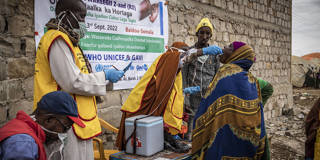As the world prepares for the next pandemic, it will be crucial to learn from the innovative and tailored strategies that lower-income countries used to immunize hard-to-reach communities against COVID-19. These efforts offer insights into how to overcome significant resource constraints and maximize vaccine uptake.
GENEVA – There was a global sigh of relief when the World Health Organization declared in May 2023 that COVID-19 was no longer a public-health emergency of international concern. But there is no room for complacency. The pandemic has represented an urgent warning about weak health systems and has served as an impetus to strengthen them ahead of a possible new variant or the emergence of a new pathogen.
The challenges of vaccine delivery, in particular, offered insights into what makes a successful health campaign. Specifically, lower-income countries demonstrated how to reach people where they are by using innovative and tailored approaches that often required collaboration among national governments, local organizations, and vulnerable communities. Their experience provides crucial lessons as the world prepares for the next pandemic.
Like their wealthier counterparts, lower-income countries had to vaccinate their adult populations against COVID-19 as quickly as possible. That meant reaching broader population groups than their existing childhood-vaccination programs could serve, while also targeting those in the greatest need: health-care workers, immunocompromised people, and the elderly.

GENEVA – There was a global sigh of relief when the World Health Organization declared in May 2023 that COVID-19 was no longer a public-health emergency of international concern. But there is no room for complacency. The pandemic has represented an urgent warning about weak health systems and has served as an impetus to strengthen them ahead of a possible new variant or the emergence of a new pathogen.
The challenges of vaccine delivery, in particular, offered insights into what makes a successful health campaign. Specifically, lower-income countries demonstrated how to reach people where they are by using innovative and tailored approaches that often required collaboration among national governments, local organizations, and vulnerable communities. Their experience provides crucial lessons as the world prepares for the next pandemic.
Like their wealthier counterparts, lower-income countries had to vaccinate their adult populations against COVID-19 as quickly as possible. That meant reaching broader population groups than their existing childhood-vaccination programs could serve, while also targeting those in the greatest need: health-care workers, immunocompromised people, and the elderly.